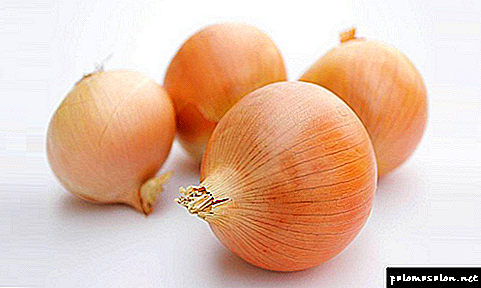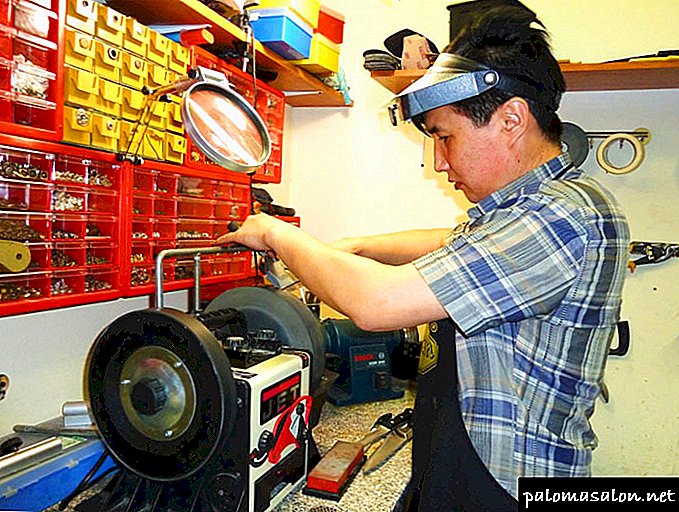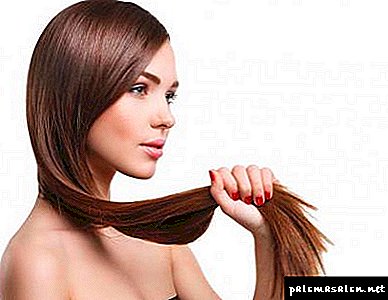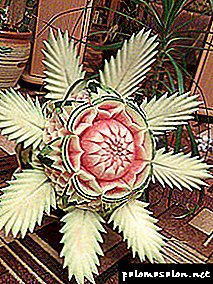
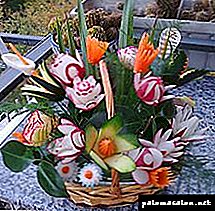
Carving (from the English. Carving - "cutting") in cooking - the art of cutting art on vegetables and fruits.
A fruit bouquet is a bunch of sliced fruit that blends harmoniously with each other. It can be collected not only fruits, vegetables and sweets, but also flowers or other leafy ornamental plants, as well as toys and other decorative items.
The art of carving came from Southeast Asia.
In Japan, in ancient times, food was served in pottery, which was covered with leaves for serving. Later, the chefs realized that a good arrangement of leaves and their cutting can give the dish an additional appeal. The art of leaf layout has been called "mukimono" (Jap. 剥 き 物). It gained official recognition in the 16th century, when Tokyo became the capital of the country.
According to a popular legend, at the royal festival of Loykrakhong in the kingdom of Sukhotai 1240–1350 (according to other sources, in 1364) a girl named Nang Noppamar presented a floating lamp decorated with a flower and a bird figure carved from vegetables and fruits. The king liked the composition so much that he declared that every woman must possess this art. Later, the art of cutting for fruits and vegetables “Kesalak” (Thai. แกะ สลัก) spread throughout the Far East and became traditional for many countries. After the 1932 revolution, carving became less popular in Thailand. Courses were held to support the fading art. Currently carving is taught in schools from 11 years.
Later carving gradually began to penetrate into Europe. However, initially here he did not get much popularity. It is supposed that the reasons for this should be found in the difference between the “table” of Asia and Europe: the Asian table needed diversity, since it was dominated by plant food and it would be desirable to give the kitchen “colors”, but the European table did not suffer from this, there was also meat, and fish, and vegetables. However, with the advent of restaurants, there was a need for a beautiful serving of dishes and original interior design. source not specified 723 days
Traditionally, almost any vegetables are suitable for carving: potatoes, large radishes, cucumbers with smooth skin, hard pumpkin and many others. Fruit is best suited for cutting smooth apples, fresh lemons and oranges, watermelons, avocados, melons, etc.
Bratusheva recommends the use of seasonal products. It is not necessary to make jewelery just before serving. Some blanks may be stored for several days in cold water or closed containers. To preserve the color of vegetables and fruits that darken after cutting, they are recommended to sprinkle with lemon juice.
Some limitations relate to the quality of specific products and methods of cutting. In order for carrots not to exfoliate, you need to pick vegetables without a pronounced core. It is preferable to use medium-sized tomatoes with uniform pulp and a small amount of seeds. Cabbage should be well kept on the stalk, and the head should be dense.
The color gamut is also important. Choosing cucumbers should pay attention to the shade of green, and leek is preferable with a pronounced white part. The ideal carving vegetable is bell pepper with its rich color palette.
For simple carving it is not necessary to have special tools. Many products can be made with a conventional knife with a sharp and elastic blade. However, there are special knives.
Primary processing is carried out using a universal knife. The main tool is the Thai knife, with its help you can cut out any patterns. Carving knives (sharp, V-shaped, square, round, wide and narrow (source?)) Are used to decorate and cut out some types of flowers. Thin edges make out with scissors. For cutting various balls, use a spoon-noisette. When cutting vegetables in long thin slices will help peeler. In addition, a knife is used for canneling (applying flutes - flutes), an engraving knife.
To fasten parts using toothpicks.
Carving techniques vary widely across countries. In the Chinese and Japanese techniques, a large number of stencils, molds and grooves are used, with the help of which people, animals and hieroglyphs are cut out. Patterns mainly depict dragons, battle scenes and greeting inscriptions. Masters from Thailand use the Thai knife and various incisors, with the help of which mainly flower compositions are created.
Masters of Asian carving use watermelons, melons, papayas and taro root, from which they carve flowers and sculptures. European carving is used to create decorations from radish, radish, beet, carrot, Bulgarian and hot peppers, zucchini, pumpkin, eggplant, onion, cabbage, cucumbers, watermelons, melons.
In the USSR, vegetable carving existed, but very few people knew about it - mainly due to the small assortment of vegetables. In 2004, the Carving Academy appeared in Russia, and vegetable carving became an integral part of all culinary competitions. source not specified 723 days
Recently, carving has become relevant throughout the world. Jewelry made from vegetables and fruits are surely present in a formal setting. Margarita Kuznetsova, author of the book on carving, believes that this art requires patience, concentration, a good eye and a hard hand.
Lately when? Bouquets are made from different fruits and chocolate source not specified 723 days .
Various carving competitions are held. Two-time world champion Xiang Wang from China became one of the organizers of the European Championship, which was first held in 2011 in Leipzig as part of the 'Gaeste' Trade Fair. The competition in two programs was attended by 26 individual participants and 11 teams, which took four hours to prepare products. The second championship was held in Moscow in 2013 as part of the PIR - the Hospitality Industry Exhibition.
Where did carving come from?
Carving, as a way of cutting fruits and vegetables, came to us from Southeast Asia. And he received his recognition thanks to one intelligent Japanese woman who presented a gift to the King, which was decorated with a heat bird carved out of fruits and vegetables. The ruler of such a gift is so sunk into the soul that he immediately announced that from now on every Japanese woman should master the ability to beautifully make masterpieces of food.
After some time, this art spread throughout the Far East, firmly rooted in Asian culture. This hobby was so much enjoyed by Eastern people that carving began to be taught in schools, as one of the main subjects that is practiced to this day.
A little later, carving appeared in Europe, where it gained no less popularity than in the East. People gladly picked up new trends, thanks to which the carving spread throughout the world. Now, in many restaurants and public places you can see beautifully decorated vegetable or fruit dishes. Fantasy authors have no boundaries, they get up such masterpieces that they just can not believe that such beauty can be done with your hands!

The difference of carving from another type of curling
1. Carving compares favorably with a perm by its more gentle effect on the hair, especially if it is naturally fragile and thin. When carving aggressive substances only envelop the core, without violating its integrity and not penetrating inside.
2. When conducting biowave used composition, one of the components of which is a biological protein, resembling human structure. When chemical perming or carving this composition is not used.
3. Despite the fact that the result obtained after carving keeps less than after chemical or bio-wave, it still looks more natural and natural.
Types of carving
Thanks to the existing types of this procedure, a woman gets a wide choice of the styling and the curls she only dreamed about.
Carving is:
1. Large. During the wave are created large, but not very pronounced waves. The image is gentle, soft and feminine. And during the procedure only large diameter curlers are used.
4. Textured. Suitable for women who want to hide the disadvantages of unsuccessful staining. As a result, the styling turns out to be quite interesting and for this purpose hair curlers are used in different shapes and sizes. This carving can be chosen for those girls whose haircut is performed in a cascade.
5. Vertical. The procedure is done for the entire length of the hair, so it is most suitable for those who have a luxurious and long hair. For curling taken vertical bobbins.
6. Local, it is also called the root. With this carving, only the root area is processed, without affecting the rest of the hair shaft. But sometimes the local perm of this type implies the creation of strands in the bottom or only in the middle zone of the head.
Carving Curlers
Since the curl itself when carving is of several kinds, then the curlers in this procedure are also used different. It:
1. Rollers (boomerangs)made of foam rubber. Most often used for small or large curls.
2. Spirals. Recreate the effect of hair twisted in a spiral. This is the kind of carving that most girls prefer. Laying in this case looks quite neat, but it keeps for a very long time.
3. Bulk curlers. They are used when a woman has a rare head of hair and she needs to get extra volume near the base of the roots. And it is these curlers with large diameter that cope with this task.
4. Koklushki. Thanks to these devices you can make "African" hair. The output is very fine and funny curls.
In fact, choose a curler, too, must be thoughtful. So, if a girl with thin hair prefers to make a carving with bobbins, the result may not meet her expectations. Since the hair will look very volumetric and shapeless. With this type of hair is better to opt for rollers for large curls.
Advantages and disadvantages of carving
What and any procedure during which the effect on the hair occurs, carving also has its advantages and disadvantages. The obvious advantages of this type of wave are the following advantages:
- has a sparing effect on the hair,
- during such a procedure, the curls themselves are more natural and natural looking, but with a chemical perm, they look like tight and lifeless curls,
- on ordinary hair, carving lasts up to three months, and if it is performed on colored hair, then the effect will please a woman for six months,
- thanks to the diversity of the types of such a procedure, each person will be able to pick up exactly their curls (large, medium, small) in accordance with the shape of the face and the type of hair,
- carving gives you a unique opportunity to make any hairstyle long-term, whether using ironing or embossed strands.
But the disadvantages of this procedure include such moments as:
- hair can begin to be strongly split, as in any case it is a chemical compound that damages hair,
- carving does not give the effect of highly pronounced curls, in this case it is better to turn to biowave,
- the chemical composition applied to the hair during the procedure has a specific odor, which is then trapped for some time and felt on the surface of the hair (especially after washing the head),
- some persons after carving note the loss of strands,
- the master can never accurately predict exactly how the curls will behave after the end of the term of exposure to such a procedure, they will simply unwind, or grow back,
- even if resorting to carving, then finally forgetting about the use of styling products will not work, the woman will still have to resort to their help to create the desired shape.
Contraindications for carving
In addition to the advantages and disadvantages of the presented procedure, it has its own contraindications.
? Avoid carving should be during pregnancy or during lactation. Composition, which is applied to the hair shaft, can not be called absolutely safe. Therefore, it is better for girls in the position to abstain from the procedure and wait for a more suitable period.
? It is also undesirable to do such a procedure in the period of menstruation or after suffering severe stress. In such cases, the hair will be difficult to style.
? It is not necessary to carry out carving immediately after dyeing the hair. Strands and so at this point are badly damaged, so they should be given time to recover.
? The body of some women may have individual intolerance used in the procedure of the composition, causing the appearance of allergic reactions. And if a girl knows about her such features, she needs to inform the master about this in order to preliminarily make a test for possible allergies.
? Another contraindication to the use of carving is the use of strong drugs, especially if they are hormonal. It is better to wait until the course of treatment is over and then resort to this type of curling.
How is the carving procedure
Carving can be obtained not only within the walls of a beauty salon, but you can try to reproduce this procedure at home. To do this, you need to follow all the recommendations, purchase a special kit with the necessary composition and within two hours a woman can be content with the result. The scheme of carving is as follows:
1. First, the head is washed, and the hair is slightly dried with a towel.
2. Next, you need to divide the hair into strands and wind each of them into pre-selected curlers or bobbins.
3. Then the applicator is lowered into the composition of a special tool from the carving kit and it processes each strand separately.
4. After that, you should put a plastic cap on your head and wrap it with a towel on top. To sustain that time which is specified by the producer on packaging with chemical solution.
5. When the allotted time has expired, the head is washed with water without using shampoo and without removing the bobbin from the hair.
6. At the end, a retainer is applied to the entire surface of the hair (it is also included in the set), it waits for some time and the curlers unwind.
7. At the very end, the curls are again washed with water without shampoo and dried using a hair dryer.
Description of the procedure
Carving is often confused not only with chemical, but also with biowave. This is because the drugs used differ in not too aggressive effect on the hair structure. They do not penetrate inside the hair shafts, but are fixed on the surface, permanently giving curls resistance. But still The main objective of this procedure is to make the hair more voluminous, but not curly. Therefore, you should not rely on elastic curls, which are obtained after the traditional chemistry.

By the way. The history of carving began with the company Schwarzkopf, who invented a method of long-term styling using twisted curlers and a special composition.
What is used
For this technology, you will need all the same as for any type of curling: curlers, composition, latch (to fix the result). Papilotki can be different. The main thing is that they are securely fastened to the hair and not unwound during styling, as well as provide the desired shape and size of curls. Of course, thermal rollers or velcro will not work.
Usually hair for easy chemistry curl on such rollers:

- spiral - suitable for forming a large number of curls. Curls come out average in size, you can read more about the spiral chemistry,


- boomerangs - used for combined styling. The result depends on the diameter of the products.
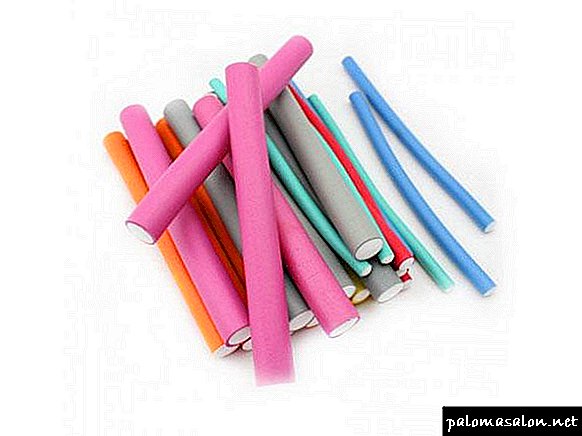
The composition used for home carving should not only guarantee long-lasting results, but also gently affect the hair. Well, if it contains keratin, vitamins. Of course, the cost of such a tool will be higher, but you should not save on beauty and health of hair. It would be better then to completely abandon gentle chemistry. Popular brands include GOLDWELL Evolution, Londa, Estel, ISO, Wella, Cutrin, Schwarzkopf and others.
The fixer should be from the same series as the composition. As a rule, manufacturers pack everything necessary for curling into one set.
Advantages and disadvantages
To the undoubted advantages of long-term styling, which resembles a light chemical. Perm, include:
- gentle effect on hair
- a result that looks like a natural hairstyle,
- additional volume for thin, rare strands. It is the owners of such curls and recommended carving,
- a variety of curling options,
- the possibility of carrying out the procedure on hair of different lengths,
- easier styling on curlers or curling - the effect in this case lasts longer,
- universality - correctly chosen carving will decorate a round or rectangular face, hide major features and highlight the merits of the exterior,
- the gradual unwinding of the curls, in which the boundaries between the curled and straight hair are not as visible as in the case of chemistry,
- lower cost compared to the biowave, which also uses gentle compounds,
- possibility of frequent correction.
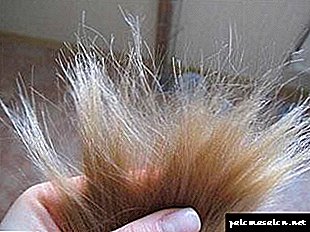 Disadvantages of the procedure:
Disadvantages of the procedure:
- hard to get elastic curls
- there is an unpleasant smell of chemicals on the hair,
- strands are still under stress: they can fall out, split into two at their tips,
- it is necessary to do the styling and properly care for the hair so that it does not unwind,
- there are restrictions to holding, including - weak, bleached curls,
- It is impossible to predict the result of gentle chemistry on thick, thick, dyed and striped strands.
Attention! Carving slightly dries hair. For owners of fat type of hair, which quickly gets dirty, this is a plus, but for those with curls dry, can be a minus.
Features given the length of hair
Due to not too steep curl, carving has almost no effect on the length of the hair. This is another difference from perm, in which elastic curls can become visually shorter by 1-2 centimeters. The thicker the hair, the more difficult it is to predict the result and duration of the effect. Thick hair rods may also not be affected by the composition. In such cases, the styling is usually not kept as long as on thin, rare strands.
Carving is combined with many haircuts. If there is a bang, it can be curled along with the rest of the strands or left as is. Reviews and photos with the results of gentle chemistry will help to better present the final version of the hairstyle. But remember that here you also need to take into account the features of appearance: oval and facial features, hair length.
Heavy, thick curls can quickly unwind. The owners of such a hair are shown classic chemistry or biowave. If the strands are light enough, vertical neutral stacking on spiral curlers will be a good choice.

The ideal length for the procedure. Hair that goes down below the shoulders can be curled into bobbins. Any other types of folders will also work to create body waves or medium-sized curls. Carving looks good with a cascade.

Due to the ease of such a length of curls contributes to long-term preservation of the result. For short strands, you can choose large curlers or simultaneously combine rollers of different sizes. The textured type of carving will successfully fall on a bob haircut or an elongated bob. Vertical perm often looks not very attractive due to the large volume.

Before performing the procedure, consult a hairdresser. The wizard will tell you whether it is worth doing carling on your curls and what kind of curlers better to take.
How to perform at home
Independent execution of the wave requires strict adherence to technology. If you do not have this experience, it is better to trust a professional. In any case, carefully prepare for easy chemistry. Make a haircut or trim the ends of the strands, pamper your locks with nourishing masks. For carving at home, especially for hair of considerable length, it is worth attracting an assistant.
Attention! Be sure to test for an allergic reaction. Put a small amount of the compound on a small area behind the ear, elbow bend or wrist, after 20-30 minutes, check. This will avoid the development of an allergic reaction during the perm.
To make your own long-term styling, prepare these materials and tools:
- composition and fixative,
- containers for breeding drugs. Optimally, if they are glass,
- sponges or applicators - 2 pieces,
- curlers of selected shape and size
- comb,
- fat cream or petrolatum,
- cotton harness
- plastic cap,
- a cape on the shoulders or an old robe,
- towel,
- gloves (if you do not go in the set to the composition).
Before the procedure, try different curling options on curlers, experiment with the diameter and number of rollers. From papillotok and features of their location depends on the overall appearance of the hair.
 Step-by-step instructions for self-carving:
Step-by-step instructions for self-carving:
- Comb the washed and slightly dried hair.
- Form strands. The thinner they are, the more pronounced the curl will be.
- Twist the curls on the papilotki.
- Carefully treat the skin along the hair growth with a rich, nourishing cream.
- Tie a cotton harness or a special bandage over it. These measures will protect the skin and hair from the effects of the composition.
- Throw a robe over your shoulders, a towel around your neck, wear gloves.
- Dilute the composition.
- Sponge it over your head with a sponge. Wet curly locks plentifully so that every hair is soaked, but do not overdo it.
- Cover the head with a plastic cap and a towel. How much to keep the drug on the head of hair - tell the instructions to him. Do not increase the recommended time - it is harmful to the hair!
- Wash your head with water, without removing the papilotki.
- Apply to the head of hair fixing composition.
- Wait for the time specified by the manufacturer.
- Carefully remove the hair curlers and rinse the hair again, dry naturally or with a hairdryer with a diffuser nozzle. No need to use shampoo. You can rinse your hair with vinegar.
How long does the effect last
On average, craftsmen in salons provide a guarantee of 1-2, less often - for 3 months. Of course, much depends on the condition, structure and length of hair, on the correct care and styling, the quality of the composition. With a successful combination of all these factors, the effect can be maintained up to 6 months. Growing up, the curls will gradually unwind, changing the shape of the original curl. If the appearance of the hairstyle has ceased to suit you, in 3-4 months you can make a correction.
By the way. It is noticed that the hair, which before carving was subjected to coloring, better keep the perm. Only it is necessary to take a two-week break between procedures.
Styling and care
 A couple of days after carving, you need to do without washing your hair so that the curls finally take shape. After that, you can wash them with shampoos for curly or damaged hair, combing - comb with rare teeth.
A couple of days after carving, you need to do without washing your hair so that the curls finally take shape. After that, you can wash them with shampoos for curly or damaged hair, combing - comb with rare teeth.
It is better to use hairbrushes with natural bristles, and remove the rest until better times. To dry the hair, use the nozzle diffuser. She will become an assistant if you are thinking of styling your hair, although the optimal way is natural drying.
To create a well-groomed hairstyle, use a special styling for curly strands. Spread it over the washed head, slightly squeezing the strands from the bottom up to the roots, and then dry with a diffuser.
To straighten the carving and make the hair obedient, voluminous, take a brush-brushing. You can use the iron, but only be sure to put on the curls of thermal protective agent.
Even a temporary perm can turn the hair into straw, if you violate the technology of the procedure or do not provide the correct hair care. Pick cosmetics for loose, damaged, curly strands. Make masks, use balms and rinses. Do not go to bed with a wet head. Blotting curls after washing, do it carefully, do not rub them with a towel. Avoid any alcohol-containing care products and trim the tips regularly.
Carving is ideal for thin, rare hairs. It has many advantages over other styling methods and classical chemistry, as it provides a fairly long-lasting result and does not damage the strands too much. It is enough to properly care for the hair, so that it always looks great. But do not neglect the contraindications, following the fashion trends to the detriment of the hair.
For experiments, only healthy curls will be suitable, otherwise you can provoke a lot of problems: tip section, loss, damage to hair shafts. Any, even a sparing effect of chemistry on the structure of the strands, is a test for hair, and your task is to help your hair to overcome it painlessly.
Carving history
As you might guess, the art of figurative carving of fruits and vegetables came to Europe from Asia. But it is still not clear who first discovered carving - the Chinese or the Thais.
Although there is a legend: after the held Loykrahhong festival in Thailand (the year is not specified, but the approximate period is the 12th century), the king liked the presented bowl with the bird and flower figures carved out of vegetables and fruits so much that he wished every woman could do this. After that, the carving spread in the East, and it became a tradition to decorate the table and dishes in this way.
Over time, the art of figure carving on fruits and vegetables began to develop in Europe. But such recognition, as in China and Thailand, did not receive carving here. Most likely, this is due to the fact that in Asia the dishes from vegetables and fruits predominate, therefore, in order to somehow diversify the table, people resorted to such tricks as carving. In Europe, the dishes were much more diverse, so they began to decorate the table with carved figurines from vegetables and fruits only with the development of the restaurant industry.
Now carving has two main styles: European and Asian. Their differences lies in:
- selection of fruits and vegetables,
- cutting technique
- some tools
- plots.
Carving knives and other tools
In order to get a good job, you must use the appropriate basic tools. In the technique of carving these are special knives. This is due to the fact that using ordinary ones, you simply will not achieve the proper result. For example, you may not get openwork patterns.
Carving knives:
- knife-peak: useful for lace cutting, suitable for large and small products,
- watermelon knife triangular,
- screw knife: used for cutting round spirals of dense vegetables and fruits (for example, potatoes, apples), core removal and stuffing,
- wavy cutter,
- knife with a square cross section: useful for cutting patterns and various shapes,
- wavy oval knife: needed to create petals
- Dovetail knife: useful for creating triangular-shaped petals,
- peel knife
- Thai knife: needed to create thin patterns on a dense skin.

Additional tools for carving:
- sharpener for carrots: helps to make carrots of various decorations (for example, flowers),
- double-sided spoon: helps to cut out spheres of different sizes from vegetables and fruits
- figured double-sided spoon,
- vegetable peeler
- tweezers,
- die cutters.
Tools for carving can be bought either individually or by sets, which are divided into regular and professional. The usual set contains only 3-4 knives. The professional set consists of several knives and additional tools (as a rule, about 10-15 pieces). The kit also includes a book and a DVD with master classes and useful tips.
Carving technique

Asian carving is a complex composition of exotic vegetables and fruits. The patterns are dominated by hieroglyphs and oriental motifs (for example, dragons and battle scenes). And in the process of cutting the master uses a variety of tools, stencils and forms.
European carving is a very beautiful and relatively affordable way to decorate a table. It uses the most simple vegetables and fruits. Intricate patterns and shapes are extremely rare.
Carving training
At the end of the 1932 revolution, the art of carving fruit and vegetables lost its share of past popularity in Thailand. Therefore, the authorities decided to conduct training courses, and today carving is taught in schools for children who have reached the age of eleven.

In European countries, there are also special training courses that provide programs for beginners, advanced craftsmen, as well as mini-programs for creating certain patterns. Such courses are not cheap, and their duration takes about seven to eight hours, which are divided into several classes. After training, you are provided with a certificate of completion of figure carving classes - kakarving. Reviews of graduates say that some are so carried away by this art that they even began to earn from it. After all, figurally cut vegetables and fruits can be sold.
At home to master the technique of carving is more difficult, but possible. To do this, you need to stock up on tools and educational materials: special literature and videos that contain lessons from real teachers in the technique of carving. Master classes from amateurs or without illustrations will not allow you to truly master this technique. This should be considered.
Master class: fruit carving for beginners
Newbies in carving can easily make a basket-vase of watermelon.

- Take a watermelon. Wash and dry it well.
- Mark lightly with the tip of the knife in the middle of the entire diameter.
- Make a single link pattern on thick paper.
- Attach the template to the wall of the watermelon, perpendicular to the drawn middle, using adhesive tape.
- Circle the pattern with the tip of the knife.
- Move the template above and transfer it to the watermelon. Draw the entire basket handle this way.
- Carefully cut off the watermelon pieces on the sides of the handle (it turns out two quarters), and do not touch the flesh under it.
- Cut through the middle of the links on the handle.
- Spoon clean the space under the handle from the pulp, leaving about two centimeters on the handle itself.
- Make curly edges half a watermelon, which serves as a basket.
- Spoon half the watermelon from the pulp, leaving about two centimeters on the walls.
- Fill the finished watermelon basket with small berries: grapes, strawberries, raspberries, cherries, cherries.
Edible basket ready!
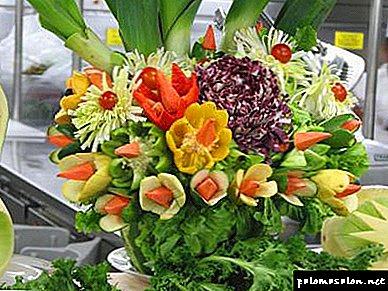
- Use only fresh and even vegetables and fruits.They should also be well washed and dry.
- Carved decorations should be combined in color and taste with the main dishes.
- All tools should be well sharpened.
- Finished work from fruit (except melon and watermelon), put for ten minutes in cold water.
Where did the name "carving" come from?
In the literal translation into Russian, the word "carving" means "cutting out" or "artistic cutting." The term is used in sports, cooking and car enthusiasts. The concept of carving, as a kind of super resistant styling, was introduced and patented by Schwarzkopf. The specialists of the corporation performed the curling of hair with the help of spiral curlers in combination with the use of a special compound, which today is sold under the eponymous brand. After the procedure, beautiful twisted curls were formed, which lasted for 1-2 months.
Today, craftsmen from different countries carry out carving using curlers of various modifications: large, small, “boomerangs”, “rollers”, etc., depending on the wishes of the client. The shape and structure of the curls turns out to be different, but the principle of styling remains unchanged.
How is carving different from perm?
Carving is called light chemistry, because it uses more gentle formulations than those used in chemical perm. Although the process of performing both types of styling is very similar.
The undeniable advantage of carving is that after it the hair is less damaged, becomes obedient and soft, unlike chemistry, after which hard, sticking curls are formed on the head, which are difficult to style. In addition, after 1-2 months, the carving effect disappears and the curls acquire a familiar texture, while curly curls persist for at least six months after a perm.
Re-carving procedure can be carried out in 2-3 months without causing special harm to the hair. Perm is allowed no more than 1 time per year.
What hair can you do carving on?
Ideal for carving - docile, slightly curly hair of medium length. In this case, the perm will last as long as possible and look the most harmonious. The denser and springy the hair, the worse the waving is taken, but an experienced master can create the necessary texture even in this case.
You can also make carving on dyed and completely bleached hair, but it is worth considering that it is better not to paint immediately before the procedure, as the composition for carving can wash out the coloring pigment and dyeing will have to be repeated. This procedure is not recommended for girls with thick highlights, because of the different structure of the hair it will not be possible to create a uniform texture on the entire surface of the head.
It is forbidden to make carving if the hair is too dry, brittle or actively fall out. In this case, you must first restore the health of the hair, and only then resist it with chemical compounds. Otherwise, you can do without hair.
But carwig will only benefit the owners of greasy hair, because the substances used for this procedure have a drying effect.
How is hair carving done?
Carving for the first time is better under the supervision of a professional, so as not to be disappointed in the result. But, if you nevertheless decided to carry out this procedure on your own or with the help of a faithful friend, you will need the following “artifacts”: composition for carving (made by Schwarzkoph, Londastyle, etc.), means for fixing the volume (same company as composition for carving), curlers of the desired size, plastic cap, gloves, non-metallic comb.
Now we proceed to the process of carving:
- Wash your head with shampoo and balsam, dry it with a towel so that your hair is slightly damp.
- Screw hair on curlers with small strands.
- Apply to each strand composition for carving using an applicator so that the hair is completely soaked, but the tool does not fall on the base of the curlers.
- Put a polyethylene cap on your head and fit for 15 minutes.
- After this time, roll out one of the strands and evaluate the result, if the hair has already taken the desired shape, you can remove all the curlers, otherwise, wait another 5-10 minutes.
- After unwinding all the curls, wash the hair well to wash off all the remnants of the carving composition.
- On wet hair, apply a means to fix the volume with springy movements and wash it off in accordance with the directions on the package.
- Dry your hair in a natural way.
It is better to refuse a hair dryer for the next week after the procedure. You can wash your hair on the day of the curling, and it is recommended to change the hair color drastically no sooner than after three days. However, it is possible to refresh the shade with the help of ammonia-free dyes directly on the day of the carving.
Before the procedure, it is advisable to consult with a professional who will tell you which carving composition will best suit your hair and evaluate the condition of the hairstyle.
Cons carving
Despite all the advantages of carving, it is not a good procedure for hair. The hairstyle is amenable to chemical attack, as a result of which it becomes more dry and porous. Therefore, after carving, get ready to reanimate your tresses with the help of nourishing hair masks.
Carving is contraindicated for women during pregnancy and lactation, because the effects of chemistry can adversely affect the health of both mother and baby.
In addition, you should not indulge in the hope that carving will relieve you of daily hair styling. Curls after eight hours of contact with a pillow can form a nest on the head during the night. Therefore, you will have to take a few minutes to bring them into a divine form.
What fruits and vegetables are suitable for carving?
Practically any dense products with firm pulp are suitable for carving. Although some craftsmen manage to make a masterpiece of even half-rotten fruit! But, nevertheless, the most popular and convenient vegetable for carving is bell pepper. Due to its bright rich color, as well as the variety of colors, it has become the number one product for decorating all sorts of dishes. It is very easy to cut out beautiful figures from it, as it has ideal hardness for this.
In order to beautifully cut a shape from fruits or vegetables, it is not necessary to have special tools for carving. This can be done with a regular sharp knife with a fairly elastic blade. If the work is to be thin and almost jeweler, then in order to make the product look elegant and neat, special scissors and knives for carving are used. Such sets can be found in any household stores that sell cutlery.
An interesting fact is that carving implies just a curly cut of fruits and vegetables, but in each country it has its own characteristics. For example, in China or Japan, various forms of carving are often used, as well as stencils and notches. Man-made masterpieces are much easier and faster to create with them. But in Thailand they like to use only knives of different sizes. Sometimes scissors are allowed. This cutting process takes a little more time, but the sculptures are unique and inimitable.
The existence of carving in the Soviet Union is also mentioned, but at that time practically no one knew about it, since fruits and vegetables were in short supply. But over time, when the USSR collapsed, several carving schools appeared, and the Soviet people defiantly picked up this idea.
Currently, carving is an integral part of all sorts of culinary and creative competitions. In order to master this technique to perfection, you will have to be patient with concentration, and good imagination. You can learn this skill yourself by finding video tutorials on the Internet, or by finding a tutor. There are also special carving courses that teach you to cut out masterpieces of fruits and vegetables in a very short time. In the video below you can observe how a rose is cut from a watermelon.
Useful videos
What is hair carving and how is it done?
Carving on medium hair. Detailed video tutorial.
Master class on carving hair in the salon.
Carving procedure
Carving is done in beauty salons by masters who have undergone special training. According to the technology, sparing compounds that do not contain theoglycolate and ammonia, as well as mixtures from the “biowave” series are used.
Carving procedure takes from one and a half to two hours. Hair is twisted on hair curlers, then the master applies a special composition to them for the necessary time, then he washes it off and dries the hair. The result is a visually thick curly curls (in its texture, the curl can be different).
There are several types of carving. To obtain the effect of curly (very curly) hair for carving use small curlers. People who prefer slightly curly curls, suitable large carving, which is done with the help of large curlers.
Carving looks good on both short and long hair. To create a basal volume, the curls are wound on curlers of different diameters.
There is a biocarping hair. Due to the use of a special composition, the structure of the hair is less damaged, and the effect of the procedure lasts longer than the usual carving. The disadvantage of this service is very expensive.
What is carving for hair
From English “carving” means “carving on wood”, but the description of this procedure would be more suitable “curving” - “curved”. All because it is a hair wrap, which lasts a long time through the use of a special composition. If you do not consider the process in detail, the result may remind the once popular "chemistry". However, the curling of hair by carving professionals is called gentle and has several varieties - the small “lamb” is in the past. Londa even had biocarving: an even lighter option.
- make your hair volume,
- eliminate the problem of confusion,
- reduce the time to create beautiful styling,
- visually give thin hair density.
Hair care after carving
After the procedure, the curls will persist until your hair is wet. To leave the curl after the next shampooing, you need to use a special shampoo with conditioner for textured hair, and then dry them naturally.
In order to straighten curls, you need to dry them with a hairdryer, pulling curls along the entire length of taking the tips. To give a “wet effect” you need to put on the hair a little gel or a special mousse.
Carving is best done on short or medium (shoulder length) hair. The effect of the procedure lasts up to a month and longer. It all depends on the formulations used to process the hair.
After carving, the hair does not require special care, although regenerating and moisturizing masks will not be superfluous. For styling curls, it is desirable to use cosmetics for textured hair.
Coloring or highlighting is recommended to be done not earlier than 72 hours after carving, and it is better to use the paint without ammonia.
It is undesirable to make carving based on light chemistry, if the hair is strongly discolored, highlights, or undergo frequent dyeing. In this case, you should pay attention to the biowave and biocarving hair.
Hair care after carving procedure
After the carving procedure, it is not recommended to wash your hair for 3 days. This is necessary to ensure that the curl lasts longer. Carving weakens the health of the hair, so they need additional nutrition and hydration. For this purpose, it is recommended to use medical masks, balsams and conditioners. Not only professional products from stores, but home-made products based on burdock root, rosehip and aloe juice are suitable for hair recovery.
While washing your hair, it is not recommended to rub the hair intensively with a towel or comb it while it is wet. You should not fall asleep with wet hair, but you should not dry it with a hairdryer either. It is better to let it dry naturally. In the summer, it is advisable to use means protecting against ultraviolet rays.
After carving, clearer curls can be laid with the help of curlers and with curling. But this should be done not earlier than 5-7 days after the procedure.
Carving in hairdressing
Professionals claim that the effect achieved from the chemical composition applied to the hair can remain unchanged up to eight weeks, after this period, the hair returns to its natural state. As a rule, such procedures are carried out only in professional salons using light means for chemical or biowave.
In contrast to the usual chemistry, carving is a more gentle procedure, which can be repeated after a few months, while the hair retains its natural softness and obedience, easier to fit into the hair and have a very attractive appearance.
Ice carving
Ice sculptures of angels, swans, antique bowls - the result of hard work of carving masters on ice. In order to create such a masterpiece, you need to complete a long-term course of study, including both the lessons of the thread itself and many additional disciplines, such as ice-casting technology, polishing and transportation, the creation of basic products and complex, composite compositions.
Culinary carving
Culinary carving is of eastern origin. Unfortunately, works of art created from “edible material” are not as durable as, for example, stone or wooden sculptures, however, they can also be fully recognized as true masterpieces worthy of public admiration.
It is not so easy to create such a work based on masterful decoration of edibles. It requires patience, diligence and special culinary tools designed for carving vegetables and fruits. Carving allows you to make a real family dinner center out of the ordinary boring dish, to give a typical meal the effect of solemnity.
It is interesting that in Russia they learned about this kind of art only a few years ago. Cut out from potatoes or carrots asterisks for salad can hardly be counted among the masterpieces of world art. Today, professional servants of the “carving cult” are able not only to successfully combine the seemingly incompatible parts of vegetables and fruits, but also the art of choosing color palettes that positively affect the psyche and mood of a person.
Carving for short hair - photo
Owners of haircuts bob, squares, etc. you have to be puzzled daily with the question of styling so that the hairstyle looks beautiful. In such a situation, carving for short hair becomes a salvation, whichever variety is chosen. Surf-curls, romantic waves with basal volume, African curls - any of the options looks advantageous and helps to texture the hair. The advantages include the fact that the carving of hair at a minimum length is held especially long.

On average
Girls who wear classic ladder, elongated square and other haircuts, in which the ends of the strands reach the shoulders or shoulder blades, were the luckiest ones. They have a comfortable average length, which is ideal for most hairstyles, including curls of various sizes and shapes. Long-term styling on medium hair on them perfectly keeps, albeit a little less in time than on a short haircut.They can make a wrap is not the entire length.

For long
If you have a braid to the waist, be prepared for the fact that even small curls will be short-lived. Carving for long hair is rarely performed, since it is an almost meaningless procedure: the effect may not last a month. For girls who still want to try, the masters recommend winding only the ends, or add volume along the length due to soft large waves. As the composition is washed out, the hairstyle will remain attractive, since it initially had a natural look and did not remind of a diligent long curl.

Classic Curling
Traditional carving is a full-length wrap on curlers of the same shape and size. Standard cylinders are used, which can be very large for waves and narrow for small curls. The master can be guided by different zoning schemes, choice of direction and angle, selected according to the task set by the client. Such light chemistry looks like a natural change in the structure of the hair with the only difference - the clarity of the curls, which do not need to be pacified daily.
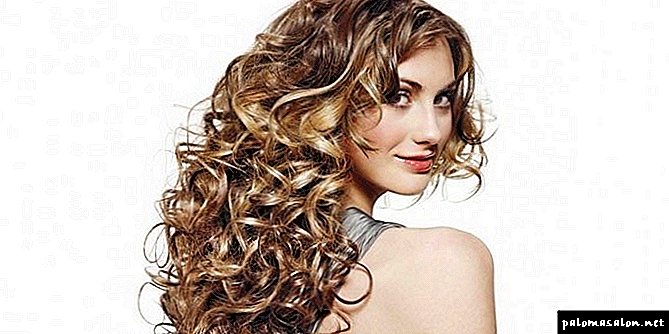
Vertical
It is used on any length of hair, it is a predominantly small elastic curls, which are obtained with the help of curlers in the form of "spiral". Make the wrap for the entire length, so it reaches the maximum amount. Professionals believe that carving upright on medium hair looks most impressive, especially if done on a stepped haircut. With an even cut, the silhouette becomes disharmonious, especially on very long hair. For short haircuts, spiral wrap is done less frequently, because dandelion is obtained.
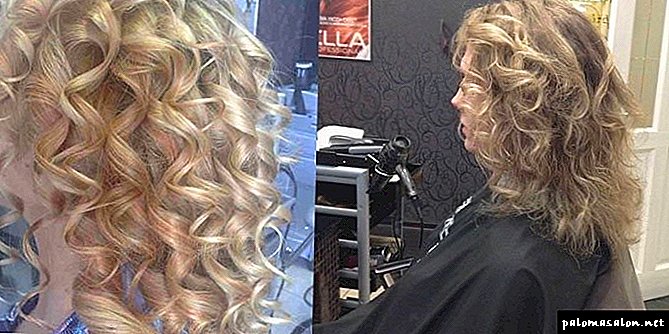
This option is suitable, if necessary, to create a basal volume, since the master only affects this zone, placing curlers under it (mainly large ones). However, local (or zonal) can be not only carving at the roots, but also a perm of the tips, which is often performed for long hair. The main advantage of this installation is in reducing the area exposed to chemical exposure, the ability to give a beautiful look to the bangs. Curlers here can be used any.

Carving or chemistry - which is better
The creators of this procedure - Schwarzkopf employees - claim that the long-term hair styling they have developed is as gentle as possible. Updating the result can be frequent - every 2 months, without fear for the health of the hair. This is the main difference between carving and chemistry. However, there are several other nuances that do not allow an equal sign between these varieties of permanent perm:
- If you get tired of walking with curls, you will not have to wait for them to grow back and cut them off mercilessly. The composition fixing the styling is temporary - it is gradually washed off by itself.
- Carving helps regulate the fat content of the roots, so you can not wash your hair every day.
- According to the technology for carrying out the procedure for carving, the master first conducts the wrap, and then sprinkles this design with a special compound. For a perm, the fixer is spread over the wet strands before using the curler.
- Carving is not forbidden to meted hair, but it will stay less than natural ones.
Contraindications to both long-term curling options are about the same:
- Thinned, parched hair, especially after bleaching, subject to any chemistry is prohibited.
- During pregnancy, a woman should not breathe such compositions, and there is no sense - changes in hormonal levels may adversely affect the result.
- It is not recommended to perform carving on henna-colored hair, as she will be washed.
The cost of this service in the salon is almost comparable to the same amount of money that you put out when purchasing a ready-made set of professional tools or even each product separately. However, buying for home use looks more profitable, because you get several procedures for the same money. Even if you order a set of Schwarzkopf in an online store with paid delivery, it will cost only 800 p.
The cost of carving hair will depend on their length. For mid-level salons in Moscow, the price range is:

